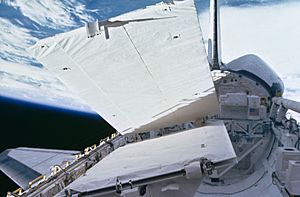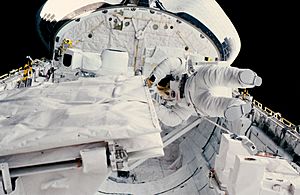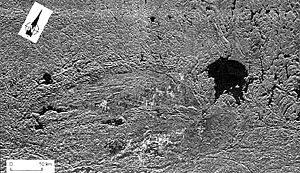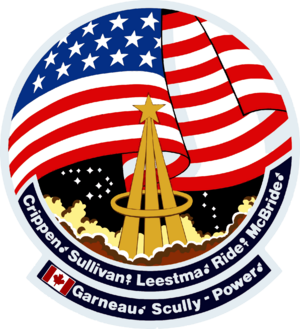STS-41-G facts for kids

ERBS during deployment
|
|
| Names | Space Transportation System-13 |
|---|---|
| Mission type | Satellite deployment Radar imaging |
| Operator | NASA |
| Mission duration | 8 days, 5 hours, 23 minutes, 33 seconds (achieved) |
| Distance travelled | 5,293,847 km (3,289,444 mi) |
| Orbits completed | 133 |
| Spacecraft properties | |
| Spacecraft | Space Shuttle Challenger |
| Launch mass | 110,120 kg (242,770 lb) |
| Landing mass | 91,746 kg (202,265 lb) |
| Payload mass | 8,573 kg (18,900 lb) |
| Crew | |
| Crew size | 7 |
| Members |
|
| EVAs | 1 |
| EVA duration | 3 hours, 29 minutes |
| Start of mission | |
| Launch date | 5 October 1984, 11:03:00 UTC |
| Rocket | Space Shuttle Challenger |
| Launch site | Kennedy Space Center, LC-39A |
| Contractor | Rockwell International |
| End of mission | |
| Landing date | 13 October 1984, 16:26:33 UTC |
| Landing site | Kennedy Space Center, SLF Runway 33 |
| Orbital parameters | |
| Reference system | Geocentric orbit |
| Regime | Low Earth orbit |
| Perigee | 351 km (218 mi) |
| Apogee | 391 km (243 mi) |
| Inclination | 57.00° |
| Period | 92.00 minutes |
 STS-41-G mission patch 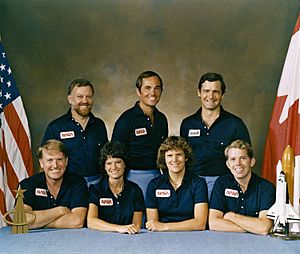 Top: Paul D. Scully-Power, Robert L. Crippen, Marc Garneau Bottom: Jon A. McBride, Sally K. Ride, Kathryn D. Sullivan, David C. Leestma. The replica of a gold astronaut pin near McBride signifies Unity. |
|
STS-41-G was an important space mission flown by NASA's Space Shuttle program in 1984. It was the 13th flight for the Space Shuttle and the sixth time the Space Shuttle Challenger flew into space.
Challenger launched on October 5, 1984, and landed back at the Kennedy Space Center on October 13, 1984. This mission made history in many ways. It was the first time seven astronauts flew together on a single space mission. It also had the first crew with two women: Sally K. Ride and Kathryn D. Sullivan. Kathryn Sullivan also became the first American woman to walk in space during this flight!
Other "firsts" on this mission included the first Australian-born person in space, Paul D. Scully-Power, and the first Canadian astronaut, Marc Garneau.
This mission also carried an IMAX camera. It recorded amazing footage of the launch and the astronauts working in space. Some of this footage, including Sullivan's spacewalk, was used in the 1985 IMAX movie The Dream is Alive.
Contents
Meet the Astronauts
| Position | Astronaut | |
|---|---|---|
| Commander | His fourth and final space flight. spaceflight |
|
| Pilot | His only space flight. spaceflight |
|
| Mission Specialist 1 | Her first space flight. spaceflight |
|
| Mission Specialist 2 | Her second and final space flight. spaceflight |
|
| Mission Specialist 3 | His first space flight. spaceflight |
|
| Payload Specialist 1 | His only space flight. spaceflight |
|
| Payload Specialist 2 | His first space flight. spaceflight |
|
Spacewalk
- Leestma and Sullivan – EVA 1
- EVA 1 Start: October 11, 1984
- EVA 1 End: October 11, 1984
- Duration: 3 hours, 29 minutes
Mission Highlights
The Challenger spacecraft launched from the Kennedy Space Center on October 5, 1984. This marked the beginning of the STS-41-G mission. On board were seven crew members, which was the largest crew ever to fly on a single spacecraft at that time.
Commander Robert L. Crippen made his fourth Shuttle flight. He was the first American astronaut to complete two space missions in the same year. The crew also included pilot Jon A. McBride, and mission specialists David C. Leestma, Sally K. Ride, and Kathryn D. Sullivan. The two payload specialists were Paul D. Scully-Power and Marc Garneau.
First American Woman in Space
Kathryn D. Sullivan made history on October 11, 1984. She became the first American woman to walk in space! She and David C. Leestma performed a spacewalk that lasted 3 hours and 29 minutes. During their spacewalk, they tested a system called the Orbital Refueling System (ORS). This test showed that it was possible to refuel satellites while they were in orbit.
Satellite Deployment
About nine hours after launch, the crew deployed the Earth Radiation Budget Satellite (ERBS). This satellite weighed about 2,307 kilograms (5,086 pounds). The Canadarm robot arm carefully released it from the Shuttle's cargo bay. The ERBS then used its own engines to boost itself into an orbit about 560 kilometers (348 miles) above Earth.
The ERBS was designed to measure energy from the Sun. It also measured how much energy Earth sends back into space. It helped scientists study how energy moves from warm areas near the equator to the polar regions.
Earth Observation Instruments
Another important part of the mission was using the Shuttle Imaging Radar-B (SIR-B). This radar was part of a set of experiments called OSTA-3. The OSTA-3 package also included other cameras and sensors.
- The Large Format Camera (LFC) took detailed photographs of Earth.
- Another camera called MAPS measured air pollution.
- A system called FILE helped identify and locate features on Earth using two TV cameras and two 70mm still cameras.
The SIR-B was an improved version of a radar flown on an earlier Shuttle mission. It had a large antenna that was 11 meters (36 feet) long and 2 meters (6.6 feet) wide. It worked throughout the flight. However, there were some problems with the Challengers communication system. This meant much of the data had to be stored on board instead of being sent to Earth right away.
Scientific Experiments
Payload Specialist Paul Scully-Power, who worked for the U.S. Naval Research Laboratory, studied the oceanography of Earth. He made many observations about the oceans during the mission.
Marc Garneau, the Canadian astronaut, carried out experiments for the Canadian government. These experiments, called CANEX, looked at different areas. They included studies on medicine, the atmosphere, climate, materials, and robotics.
The mission also carried several Getaway Special (GAS) canisters. These small containers held various experiments. They tested different materials and explored physics concepts in space.
Mission Conclusion
The STS-41-G mission lasted 8 days, 5 hours, 23 minutes, and 33 seconds. During this time, Challenger traveled over 5.2 million kilometers (3.2 million miles). It completed 133 orbits around Earth.
The Shuttle landed safely at the Shuttle Landing Facility (SLF) at Kennedy Space Center. This was on October 13, 1984. It was only the second time a Space Shuttle mission had landed at Kennedy Space Center.
Mission Patch
The mission patch for STS-41-G has a special meaning. The 13 stars in the blue part of the U.S. flag on the patch show that this was the 13th Space Shuttle flight. There are also 17 stars in the black part, which was the mission's original number, STS-17.
In the center of the patch, there is a gold astronaut pin. This pin is given to astronauts after their first spaceflight. It represents the fact that most of the crew members on this mission were flying in space for the first time. The patch also shows gender symbols next to each astronaut's name and a Canadian flag icon next to Marc Garneau's name.
Wake-up Calls
NASA started a fun tradition of playing music to astronauts to wake them up. This began during the Project Gemini program. The first time music was used to wake up a crew was during Apollo 15. Each song is chosen carefully, often by the astronauts' families. The songs usually have a special meaning to an astronaut or relate to their daily activities in space.
| Flight Day | Song | Artist/Composer |
|---|---|---|
| Day 2 | "Flashdance... What a Feeling" | Irene Cara |
| Day 3 | "Theme From Rocky" | Bill Conti |
See also
 In Spanish: STS-41-G para niños
In Spanish: STS-41-G para niños


